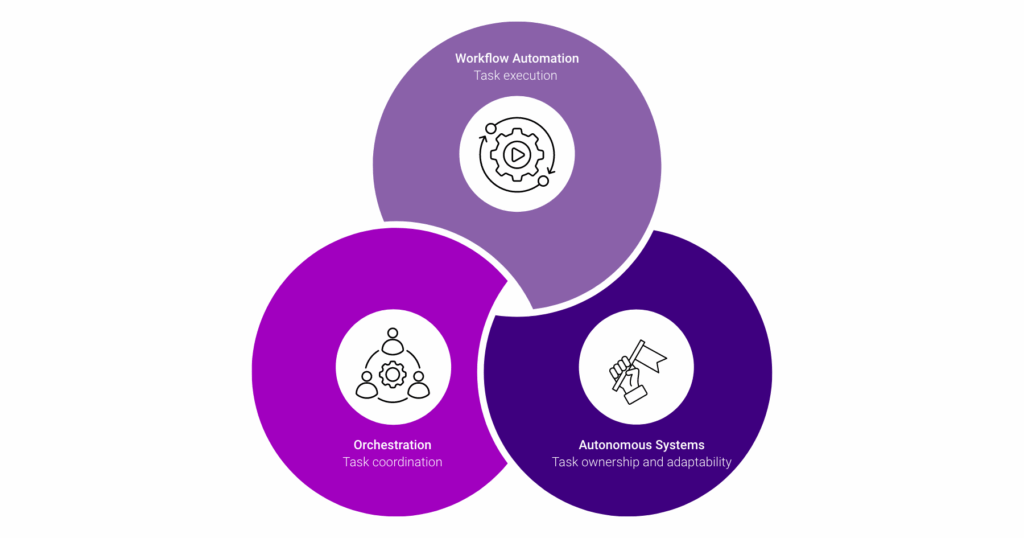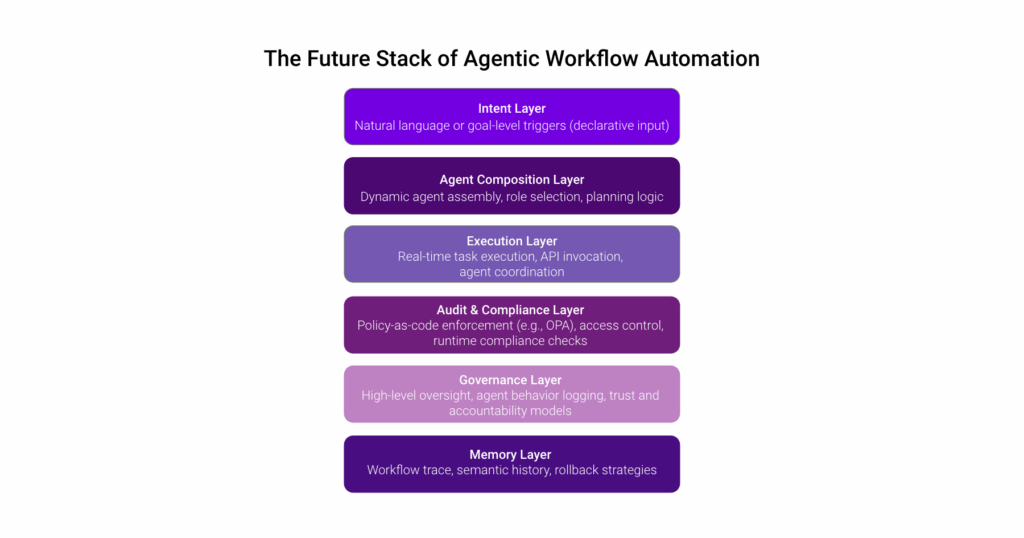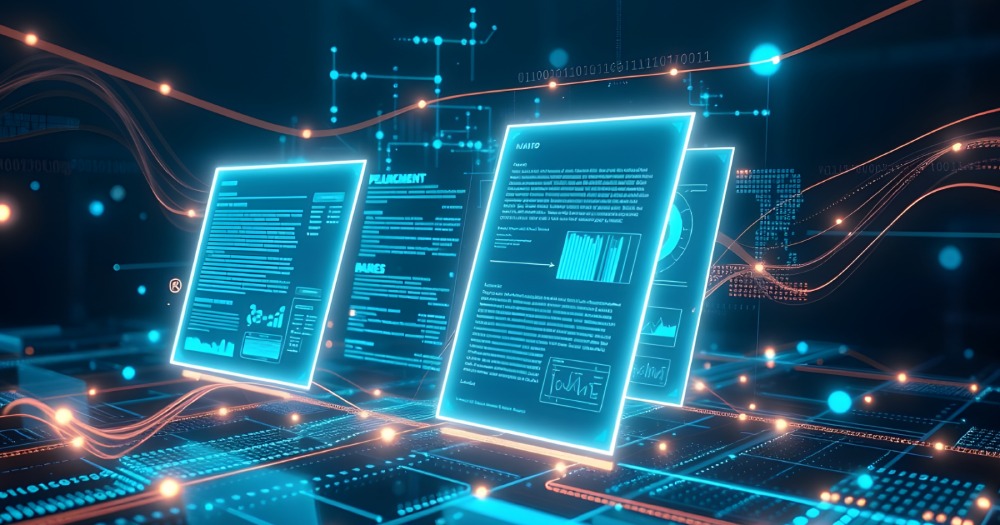Workflow automation refers to the ability of autonomous agents to initiate, execute, and adapt business processes.
In Agentic AI, workflow automation refers to the ability of autonomous agents to initiate, execute, and adapt business processes without rigid, pre-coded rule sets or manual oversight. Unlike traditional automation, these workflows are dynamic, goal-driven, and continuously optimized through real-time agent collaboration.
Detailed Definition & Explanation
In the context of Agentic AI, workflow automation refers to the ability of autonomous agents to initiate, execute, and manage structured or semi-structured business processes without continuous human direction. Unlike traditional automation, which relies on static workflows and pre-defined logic, agentic workflows are dynamic, goal-driven, and context-aware.
Agentic AI shifts workflow automation from hard-coded rule execution to intelligent task fulfillment. Micro-agents can interpret triggers, launch processes, interact with APIs, and collaborate across systems, all while adapting their actions in real time based on feedback or new data.
It’s important to distinguish workflow automation from two closely related concepts:
- Orchestration manages how agents, tasks, and systems work together; it’s the coordination layer that may include workflow automation as a sub-function.
- Autonomous systems refer to the agents themselves; the execution layer that owns and adapts the workflow based on objectives and context.
In short, workflow automation is what agents do, orchestration is how they coordinate, and autonomous systems are who’s doing it.

How Workflow Automation Works in Agentic AI
Agentic workflow automation typically unfolds in the following way:
- Trigger Detection: An event or condition—including natural language input (e.g., “process my claim”)—activates a workflow. Common triggers include new claim submissions, order placements, or SLA breaches.
- Agent Activation: A micro-agent is deployed—based on its domain expertise (e.g., fine-tuned prompts, tool capabilities, embedded knowledge)—to handle the task or process autonomously.
- Task Execution: The agent performs multi-step actions: accessing data, invoking APIs, sending communications, or collaborating with other agents.
- Contextual Adaptation: Unlike rule-based bots, agents evaluate outcomes mid-process and adjust next steps dynamically, rerouting, escalating, or retrying as needed.
- Completion and Handoff: The agent closes the loop or transfers context to the next actor (human or digital), ensuring continuity without duplication.
This adaptive cycle makes workflow automation in Agentic AI resilient, flexible, and business-outcome aligned, unlike brittle automation scripts or static RPA bots.
Why It Matters
Speeds Up Operations at Scale
Agentic workflow automation minimizes latency between task initiation and completion. Micro-agents use event-driven architectures (e.g., API triggers, message queues) to execute workflows instantly, whether it’s generating a quote, updating a CRM record, or triggering approval flows. In high-volume environments like customer onboarding or claims intake, this results in throughput gains without needing parallel human oversight.
Reduces Risk and Human Error
Agents follow dynamic decision trees and validation rules embedded into orchestration logic. In insurance or financial services, this ensures compliance with regulatory frameworks (e.g., KYC, GDPR, HIPAA) while maintaining full audit trails. Agents can auto-flag anomalies, enforce document completeness, or reject incorrect inputs in real time, drastically reducing manual errors and downstream correction costs.
Drives Personalization at the Process Level
Unlike static BPM tools, agentic workflows adjust based on individual user signals (e.g., purchase history, behavior patterns, support interactions). For instance, in e-commerce, an agent might adapt its follow-up strategy based on cart abandonment behavior. In higher education, the same agent framework can tailor enrollment flows or advising sessions to a student’s academic profile and intent.
Frees Human Talent for High-Value Work
By automating low-complexity, repetitive tasks (e.g., form validation, triage, data reconciliation), agentic workflows reduce task context-switching and cognitive load. This allows human teams to focus on exception handling, creative strategy, or empathetic decision-making. Agents can also escalate edge cases or unresolved loops directly to humans, with full context packaged for fast resolution.
Foundational for Agentic AI Maturity
Workflow automation provides the execution layer that enables multi-agent coordination and orchestration. Agents need reliable, autonomous execution environments to operate at scale. As agents collaborate across functions (e.g., claims + payments + service), workflow automation ensures that each step is completed, handed off, and optimized, forming the infrastructure for true agentic ecosystems.
Real-World Examples
ReAct Agent Framework (Google DeepMind)
ReAct (Reason + Act) enables agents to build and execute multi-step workflows using reasoning traces and tool invocation. Instead of following pre-defined flows, agents dynamically decide what actions to take based on the context of the task, chaining tools like search, APIs, and calculators in real time.
CrewAI
CrewAI enables autonomous workflow execution by assigning specialized agents (e.g., researcher, planner, executor) to collaborative “crews.” Each agent handles a role within the workflow, communicating via shared goals and real-time outputs to complete tasks like content generation, report assembly, or research validation.
FD Ryze
FD Ryze powers enterprise workflow automation through autonomous micro-agents that interpret events, route tasks, and adapt processes in real time. From processing insurance claims to managing e-commerce returns, Ryze enables workflows that evolve with business logic and customer context without static scripting.
What Lies Ahead

Declarative Workflow Programming for Agents
Agentic systems will move toward declarative workflow definitions, where agents interpret high-level intents or goals (e.g., YAML or JSON-based DSLs) rather than follow imperative scripts. This enables real-time adaptation without hardcoding flow logic.
Agent-Driven Workflow Composition
Agents will be capable of composing their own workflows by querying tool registries, selecting capabilities, and chaining API calls or sub-agents dynamically; a step toward autonomous task planning and execution without manual orchestration.
Runtime Policy Enforcement Layers
Future agentic workflows will include built-in runtime governance layers, enforcing compliance, audit trails, and access control policies via sidecar agents or policy-as-code frameworks (e.g., OPA).
Multi-Agent Workflow Negotiation Protocols
Agents will engage in workflow-level negotiation, dynamically determining task delegation, sequencing, and conflict resolution using shared memory, vector embeddings, or inter-agent messaging protocols (e.g., Pub/Sub or gRPC).
Semantic Workflow Memory and Replayability
Workflows will be embedded with semantic memory layers, allowing agents to reference past execution traces, reuse successful strategies, or rollback based on outcome audits, enabling self-optimization and explainability.
Related Terms
- Agentic AI
- Multi-Agent Systems
- Intelligent Automation
- API Orchestration
- Workflow Orchestration
- Decision Intelligence
- Autonomous Agents
- Robotic Process Automation (RPA)
- Hyperautomation
